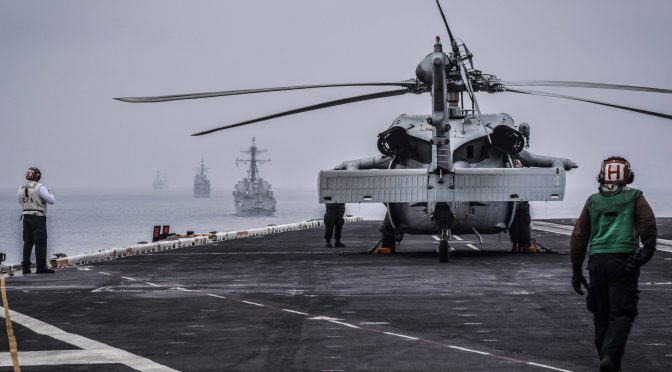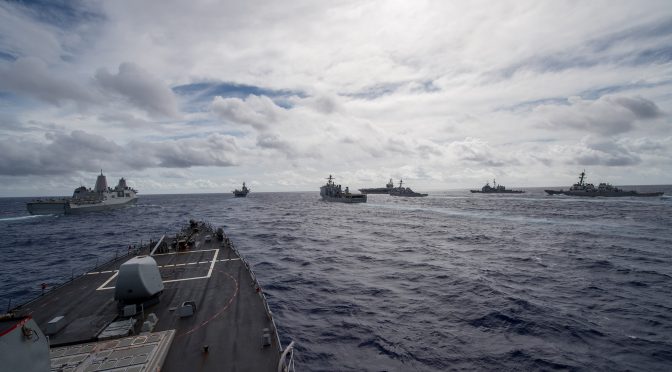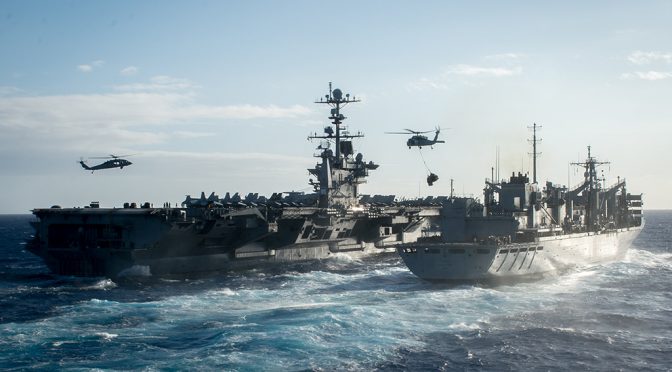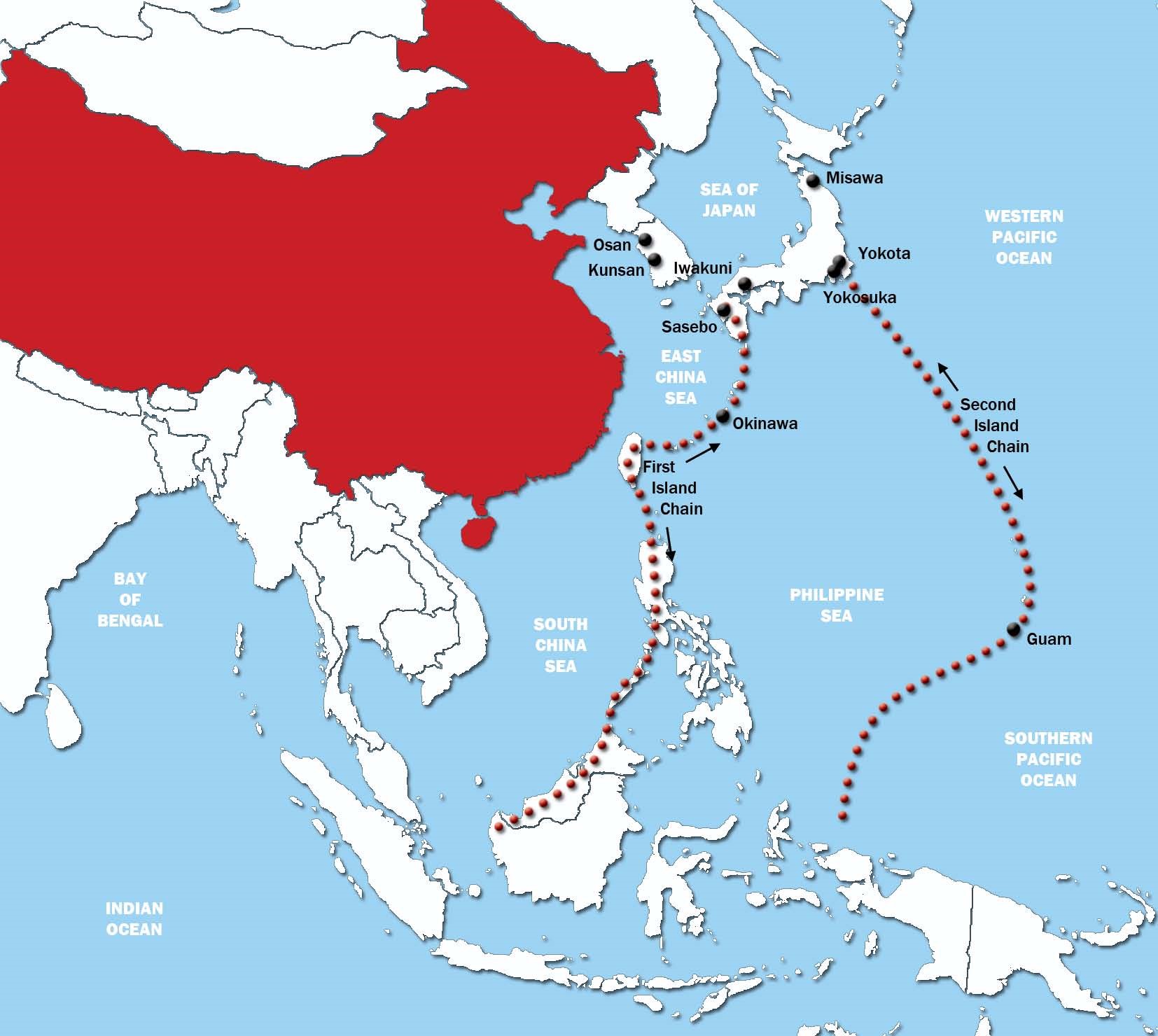By David Tier
America has grown weary of the post-9/11 wars. Long, drawn-out conflicts have worn down American resolve and left many defense officials nostalgic for “the good-old days” when adversaries were easier to describe and devoted military efforts toward preparing for conventional warfare. Seizing an opportunity, the U.S. Navy has capitalized on growing disillusionment and sought to exaggerate the military challenges posed by an ascendant China for parochial benefit in terms of gaining larger budgets and greater quantities of more expensive ships. The Navy should consider an external strategy review that accounts for efficiency as an aspect of its operating concept. This article reviews America’s current naval strategy and is divided into two parts. Part 1, below, analyzes U.S. naval defense strategy in light of 21st Century national defense threats. Part 2 will recommend changes to the Navy’s force structure to gain significant cost savings while still satisfying America’s naval defense requirements.
Introduction
In 1987, William W. Kaufmann analyzed U.S. Navy force requirements and determined that the Navy sought to procure a force much larger than necessary to meet realistic Cold War-era force projection demands.1 His review dissected the Navy’s threat assessments and his work was used as a successful tool to stunt the Navy’s attempts at inducing greater budgets. Today, in much the same way as then, we see the Navy favor approaches like AirSea Battle and “sea-basing” that counter anti-access/area-denial strategies but are anchored in conventional warfare concepts that discount the less-sophisticated threats more likely to challenge our nation. The attention and resources diverted from chasing terrorists on land will almost surely have negative consequences for the U.S., while the challenge of using naval power to forcefully gain access into contested regions will likely not be necessary, or perhaps even suicidal if tried. Despite implications to the contrary of the Navy’s parochial interests, naval officers should advise America’s leaders that the danger of being denied military access to a theater of operation is manageable and that the threat of terrorism is the greater national security problem. To do otherwise puts American interests at greater risk. This article explores the Navy’s missions in the context of the current strategic environment, proposes adjustments to its missions to align with its national defense role, analyzes the number of platforms and capabilities required to counter projected threats, and recommends reallocating budget to reduce excessive capacity in the Navy’s force projection mission in favor of sustaining the Army and Marines’ counterinsurgency capability.
The Navy’s Missions
Throughout its nearly 70-year history, the Department of Defense has struggled to build a joint force portfolio that distributed resources in proportion to priorities established in the national defense strategy. However, intra-service politics often hampered efforts to cross-level in line with the strategy and each Service wound-up with nearly equal budgets instead. There have been a couple of noteworthy exceptions to this strategy-to-resources mismatch, however. The Eisenhower Administration’s policy of “massive retaliation” emphasized the role of nuclear forces over conventional, whereby the Air Force and Navy benefitted from budget increases at the expense of the Army. The Kennedy Administration reversed Eisenhower’s course with its “flexible response” policy, which sought to improve the Army’s ability to withstand a conventional attack in Europe as well as to develop counterinsurgency forces.
The military strategies that followed these policy changes gave birth to a principle that the U.S. should maintain capability to simultaneously fight at least two major regional wars. The U.S. maintained this defense strategy for decades and only recently sought to scale back. Still, not all was smooth sailing in the Defense Department, as defense analysts noted the need to curb budget waste that resulted from factors ranging from Congressional pork barrel projects to misplaced Service priorities. Kaufmann observed that the Navy had drifted off course in his 1987 analysis titled, A Thoroughly Efficient Navy.
At the time the Navy sought a 622-ship fleet cruising with 15 aircraft carriers, and submitted budget requests based on a vision articulated in 1986’s The Maritime Strategy. Overseen by then-Chief of Naval Operations Admiral James Watkins, the document went so far as to envision decisive warfare against the Soviet Navy called “Carrying the Fight to the Enemy,” which advocated using naval power to attack the flanks of the Soviet Union during the course of a potential war.2 The Maritime Strategy persuaded defense planners of the need for a large Navy to accomplish this end.3 Although the Navy advertised its conclusions to justify necessary means to accomplish assigned missions, outsiders viewed it as a parochial argument intended to gain force structure.
Kaufmann deconstructed the Navy’s approach and determined that a naval attack against the Soviet Union would incur losses that outweighed the value of the strikes, or might even be suicidal.4 In his analysis of the maritime threats, he observed an overstated stated need for aircraft carriers, and proposed force reductions that would have substantially curbed Navy carrier-building.
Like The Maritime Strategy, the Navy’s 2015 A Cooperative Strategy for 21st Century Seapower is similarly off course. Section III of the document, titled “Seapower in Support of National Security,” overstates the need to achieve “all domain access” and to project power. It conditions the reader to expect that inflated anti-access threats imply that the most prudent solution is to apply brute force of naval power. One must examine the Navy’s purpose and missions within the context of today’s strategic security environment to establish a baseline for more reasonable Navy force requirements.
Notwithstanding the national defense strategy’s pivot to the Asia-Pacific, the Navy’s enduring missions in priority sequence are:
1. Protect the U.S. and deter enemy attack, particularly from seaborne threats
2. Secure economic sea lines of communication (SLOCs) to support national livelihood
3. Deny an adversary the use of the sea for military advantage
4. Secure military SLOCs to ensure access to distant theaters of operation, and enable military transport vessels safe transit to discharge their matériel in support of joint operations inland from the sea
5. Project forces that can attack adversary interests on land in support of other combat operations
Some may argue that these missions omit important tasks that the Navy is required to perform and others may argue that they are incorrectly prioritized. However, these arguments do not hold water. Although there is no mission listed above to provide “presence,” humanitarian assistance and disaster relief, or establish maritime superiority, these missions can be accomplished with the same assets needed for the other missions described, or otherwise derived from a combination of them. Forces conducting the first mission could assist humanitarian relief efforts and, in effect, the second, third, and fourth missions combine to describe graduating levels of sea superiority. No further forces would be necessary to accomplish these other missions. A close examination of the five listed missions can help identify and determine the capabilities required of America’s Navy.
Reconsidering Threats and Missions
First, protecting the nation from attack is the purview of all armed forces. Military threats to the U.S. are the primary reason America should procure military capability. Naturally, the Navy’s portion of this mission should focus on seaborne threats and, to an extent overlapping with the Air Force, threats overflying the sea. The primary maritime military threat to the United States today is the threat of ballistic missile submarines operating within firing range of American shores. There is no real threat of an amphibious attack against the U.S. There is also no serious threat of any enemy carrier or surface strike group threatening American territory, nor will there be any in the foreseeable future. The threat of submarine-launched missiles however, particularly nuclear ballistic missiles, should be the number one priority for the Navy to defeat. Therefore, the capability to detect, track, and destroy “boomers,” and even intercepting their missiles, should be the Navy’s primary focus. This places a premium on anti-submarine warfare (ASW) platforms such as long-range patrol aircraft, attack submarines, ASW helicopter-equipped surface action groups, and ballistic missile defense systems such as Aegis-equipped ships. Although fixed-wing ASW aircraft aboard an aircraft carrier also perform well in this role, aircraft carriers are not optimally employed in ASW and are an inefficient means to address this threat. Likewise, nuclear deterrence through deployment of U.S. ballistic missile submarines is an important capability for the Navy to maintain as part of the strategic deterrence triad. In conjunction with the other legs, it helps discourage enemy attacks against the U.S. by providing a credible second-strike threat.
Second, securing SLOCs to enable global maritime traffic and foiling an enemy’s attempt to blockade the U.S. is a vital maritime mission that ensures the nation’s way of life can continue despite attempts to wage war against it. This mission does not include protecting traffic in or through an active theater of war, but requires a capability for the Navy to establish safe lanes of transit from the territorial waters of the U.S. to the territorial waters of major international shipping ports around the globe. The primary military threat that sea-going commercial traffic might encounter would be attack submarines, although land-based long-range attack aircraft, and, to a lesser extent, surface groups or small water craft, could pose a threat. Accordingly, these threats require the Navy to maintain a transoceanic ASW capability, defensive anti-air warfare (AAW) capability, and the capability to defend against smaller surface threats. These are largely the same capabilities required in the first mission above, and greater numbers of the same types of assets can effectively be used for this second purpose.
The third mission for the Navy is to deny, or at least inhibit, enemy use of the sea for military advantage. An enemy must not be able to outflank land forces using maritime maneuver. This is where the need for sea-based fixed-wing attack and air-intercept aircraft makes their first appearance, as the Navy needs a limited strike and air combat capability to prevent an enemy from gaining localized sea control. America’s potential adversaries, however, do not furnish a strong blue-water capability that threatens to overturn the Navy’s long-established control of the sea. Even the most vaunted projected maritime threat, the People’s Liberation Army Navy of China (PLAN), will possibly field three aircraft carriers in the coming years, 85 ocean-going surface combatants, and nine nuclear-powered attack submarines.5 Although this may sound like a substantial challenge at first glance, a closer look assuages concern about blue water contests with the Navy. In a potential war against the U.S., the PLAN would not survive beyond the reach of land-based air cover since the Navy’s attack submarines would almost assuredly destroy their task forces on the open seas, and even be a significant threat for PLAN forces in their home waters. Furthermore, the Air Force’s long-range bombers would severely hamper Chinese maritime freedom of maneuver outside of the East and South China Seas. Therefore, only a few cruise missile-equipped ships, and possibly a single aircraft carrier with multi-role fixed-wing aircraft would be necessary to accomplish this third mission per theater of war. Even the amphibious assault ship-based U.S. Marine Corps attack aircraft may sufficiently address this role. A joint task force of attack submarines, amphibious assault ships, and Air Force strike aircraft could fulfill this task, thus lessening the demand for supercarriers.
The fourth mission for the Navy is to secure SLOCs into a theater of war, which necessitates a stronger offensive capability. This mission includes the possibility of forcefully gaining access to contested theaters and, combined with the second and third, accounts for the Navy’s desired capability of sea control as articulated in the Navy’s vision statement, A Cooperative Strategy for 21st Century Seapower.6 The AirSea Battle concept envisions the most challenging aspect of this fourth mission. AirSea Battle considers a worst-case scenario where the Navy must escort military transports into the full weight of sophisticated enemy defenses—within ample range of the enemy’s inventory of attack aircraft, cruise missiles, attack submarines, and mines. However, there are only a few locations in the world where Navy forces would have to confront this most challenging task by themselves, and only one current location where this is even conceivable: the South China Sea. Regardless, even the worst-case scenario there would probably require no more naval forces than required during Operation Desert Storm or in the opening phase of Operation Iraqi Freedom where the Navy deployed six aircraft carriers in each instance.7 Although this may seemingly vindicate the Navy’s need to maintain a double-digit number of carriers, we must be realistic about the threat faced. Admittedly, the challenge to escort convoys would substantially increase as task forces approached theaters of war but the chance that regional partners would not allow greater basing access assumed in some studies is overly pessimistic. This, combined with the low likelihood that a severe South China Sea problem would actually occur, reduces the challenges posed.
From a different perspective, consider more pessimistic accounts such that there were no bases in the region from which American forces could launch attacks, no allies contributing meaningful forces to assist the cause, and an enemy force that actually developed into the great adversary it is predicted to become. Were six carriers required in both wars against Iraq that sought to eject entrenched forces from an occupied country or force regime change as the 1991 and 2003 military missions respectively, or was that overkill? Couldn’t four carriers have accomplished the more limited objective of simply “gaining access” to that theater? Self-serving parochial aspects aside, the Navy should recognize that overselling the capability to execute a highly-contested South China Sea mission under the worst circumstances promises to divert resources that could be employed against other, more likely threats, such as transnational terrorism.
The Navy has encountered difficulties persuading defense planners of the full narrative for its fifth mission—power projection—since the end of the Cold War. The Navy should indeed maintain a capability to project power into distant theaters of operation since there is great value in an ability to assail an enemy in as many ways as possible. The main problem with the Navy’s approach, however, is that it single-mindedly envisions large carrier strike groups for this role. Carrier strike groups should, at best, only be one part of a comprehensive package that could be accomplished by guided missile-capable attack submarines alone or with surface combatants, and possibly to a greater degree, by long-range bombers and tactical aircraft controlled by the Air Force. This is a joint, overlapping mission set. Because the power projection argument has lost favor in recent years, the Navy has sought a different narrative to justify its service size. Hence, the AirSea Battle concept was born.
Conclusion
This examination has identified, prioritized, and placed limiting stipulations on five core missions the Navy must accomplish. Next, an examination of the Navy’s present forces it has to carry out these missions, particularly its aircraft carriers, will help determine if there is excess capability it could reduce in favor of other national defense interests.
David Tier is a Lieutenant Colonel in the U.S. Army and serves as a strategic plans and policy officer. He holds a Master in Public Administration from the Harvard Kennedy School, has served three combat tours of duty in Iraq, served a tour of duty in the Pentagon, and has authored several articles. The views expressed here are those of the author and do not necessarily reflect the policy or position of the U.S. Government, Department of Defense, or any of their components.
References
1. William W. Kaufmann, A Thoroughly Efficient Navy (Washington, D.C.: The Brookings Institution, 1987), 123.
2. Admiral James D. Watkins, The Maritime Strategy, (Annapolis, MD.: US Naval Institute Proceedings Supplement, January 1986), 9-13; John B. Hattendorf, Ph.D., Peter M. Swartz and Eds., U.S. Naval Strategy in the 1980s, (Newport, R.I.: Naval War College Press, 2008), 221.
3. Hattendorf, Swartz, and Eds., U.S. Naval Strategy in the 1980s, 204.
4. Kaufmann, A Thoroughly Efficient Navy, 102-104.
5. Kenji, Minemura, “China to start construction of 1st aircraft carriers next year,” The Asahi Shimbun, December 31, 2008, available online at http://web.archive.org/web/20090526192305/http://www.asahi.com/english/Herald-asahi/TKY200812310046.html, accessed on October 16, 2014.
6. Department of the Navy, A Cooperative Strategy for 21st Century Seapower, March 2015, 22.
7. U.S. Navy Captain (Ret.) Marty Erdossy, “Why Does The United States Only Have Eleven Aircraft Carriers?” Forbes.com, available online at http://www.forbes.com/sites/quora/2012/07/17/why-does-the-united-states-only-have-eleven-aircraft-carriers/, accessed on October 16, 2014.
Featured Image: PACIFIC OCEAN (May 3, 2017) Sailors aboard the aircraft carrier USS Theodore Roosevelt (CVN 71) observe the guided-missile destroyers USS Sampson (DDG 102), USS Halsey (DDG 97), USS Preble (DDG 86) and guided-missile cruiser USS Bunker Hill (CG 52) during a Group Sail training unit exercise with the Theodore Roosevelt Carrier Strike Group. (U.S. Navy Photo by Mass Communication Specialist 3rd Class Spencer Roberts/Released)





